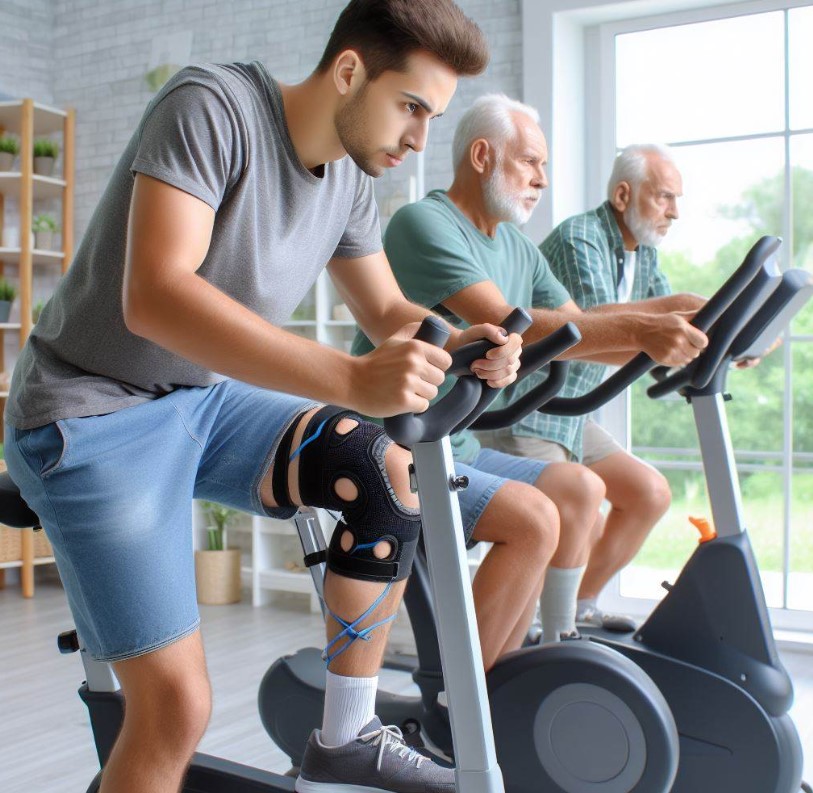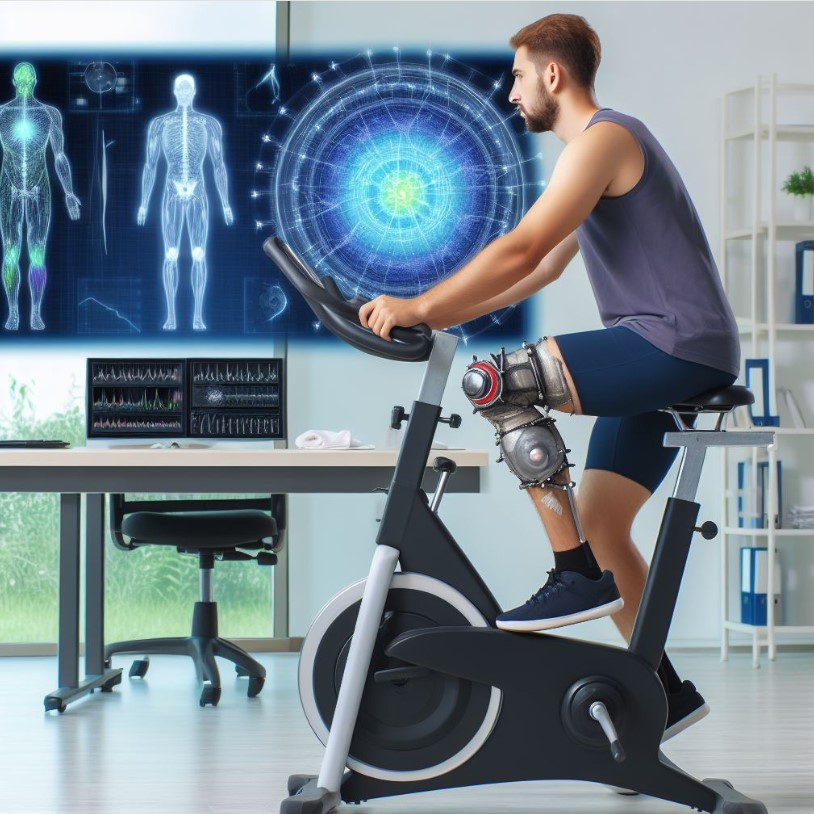How Long To Ride Stationary Bike After Knee Replacement?
Recovering from knee replacement surgery involves careful and strategic rehabilitation. So, How Long To Ride Stationary Bike After Knee Replacement? is a critical question for many patients. Stationary biking stands out as a low-impact exercise that significantly aids in the recovery process. It not only helps in improving joint mobility but also strengthens the surrounding muscles, ensuring a quicker and safer return to daily activities.
Key Takeaways
- Begin stationary biking as soon as your doctor approves, usually within a few weeks post-surgery.
- Start with short durations, 5-10 minutes per session, and gradually increase.
- Monitor pain levels and knee response; adjust intensity and duration accordingly.
- Use the stationary bike to improve knee range of motion and strength.
How Long To Ride Stationary Bike After Knee Replacement?
After knee replacement surgery, patients can typically start riding a stationary bike as early as 2 to 4 weeks post-operation, beginning with short sessions of 5 to 10 minutes and gradually increasing as tolerated, under the guidance of a healthcare professional.

The Role of Stationary Biking in Knee Replacement Recovery
Stationary biking offers a low-impact way to enhance knee flexibility and strength after surgery. Initially, you might start with passive biking, moving to active cycling as your recovery progresses.
It’s essential to maintain a comfortable pace and avoid overexerting the newly replaced knee. The controlled motion helps in reducing stiffness and improving blood circulation, significantly aiding in the healing process.
Moreover, stationary biking strengthens the muscles around the knee, such as the quadriceps and hamstrings, which is vital for knee support and function.
Regular sessions contribute to better joint mobility and can expedite your return to normal activities. Patients should aim for consistency rather than intensity in the early stages of their recovery.
Setting Up Your Stationary Bike
Proper bike setup is critical to avoid unnecessary strain on your knee. Ensure the seat height is adjusted so that your legs have a slight bend, even at the pedal’s lowest point. The correct seat position prevents hyperextension and excessive bending of the knee, reducing the risk of pain or injury.
Additionally, the handlebar height should be adjusted for comfort, encouraging an upright posture and reducing strain on the back and shoulders. Starting with a proper setup can significantly enhance the effectiveness of your biking sessions and provide a more comfortable experience during your recovery period.
Gradual Progression in Cycling Duration and Intensity
Begin your cycling journey with short, manageable durations, gradually increasing as your endurance and knee strength improve. Initially, aim for 5 to 10 minutes per session, gradually extending time as tolerated. It’s imperative to listen to your body and stop if you experience pain beyond mild discomfort.
As your recovery advances, you can increase the resistance level slightly to build muscle strength. However, the focus should always be on maintaining a smooth, controlled motion to prevent any setbacks in your recovery. Regular consultations with your physical therapist can guide the appropriate progression in your cycling routine.
Monitoring Your Recovery and Adjusting Accordingly
Paying attention to how your knee responds during and after cycling is crucial. Some swelling and discomfort are normal, but significant pain or increased swelling indicates you may need to reduce the duration or intensity.
Keeping a log of your sessions, including duration, resistance, and any discomfort, can help track your progress and discuss with your healthcare provider.
Ensure to incorporate rest days into your routine to allow your knee to recover. Balancing activity with adequate rest is key to a successful recovery. If you encounter any setbacks, consult your healthcare professional before continuing or increasing your cycling activities.
Incorporating Other Rehabilitation Exercises
While stationary biking is an excellent rehabilitation tool, it should be part of a comprehensive recovery plan. Incorporating other exercises, as recommended by your physical therapist, can provide balanced strength and flexibility training. These may include leg lifts, ankle pumps, and gentle stretching exercises.
Balancing stationary biking with other forms of physical therapy ensures a well-rounded approach to recovery, promoting strength, flexibility, and endurance throughout the healing process. Always follow your healthcare professional’s advice on integrating different exercises into your rehabilitation regimen.
Is Stationary Bike Good For Total Knee Replacement?
Yes, a stationary bike is considered highly beneficial for total knee replacement recovery. Cycling on a stationary bike provides a low-impact form of exercise that helps enhance the range of motion, strengthening the muscles around the knee, and improving blood circulation without placing excessive stress on the knee joint.

The controlled, smooth motion of cycling helps reduce stiffness and promotes healing in the replaced knee. Additionally, it can also aid in managing pain and swelling post-surgery. The repetitive motion helps in lubricating the knee joint, which is crucial for improving mobility and flexibility.
It is, however, important to start with the guidance of a healthcare professional to ensure the bike is properly adjusted and the exercise is performed correctly to prevent injury and ensure optimal recovery.
Is Stationary Bike Good For Knee Rehab?
Stationary biking is excellent for knee rehabilitation for several reasons. First, it offers a safe, controlled, and low-impact exercise option, which is ideal for strengthening the muscles around the knee without excessive strain.
Strengthening these muscles, particularly the quadriceps and hamstrings, is crucial for supporting the knee joint and improving its function post-injury or surgery.

Secondly, cycling helps in enhancing the knee’s range of motion gradually, which is a key component of knee rehab. Furthermore, the risk of falling or further injuring the knee is minimal compared to other forms of exercise.
Regular, moderate stationary biking can accelerate the healing process, reduce pain, and improve overall knee health during rehabilitation. However, it is essential to consult with a healthcare professional before starting or adjusting any rehab exercise to ensure it aligns with individual recovery goals and health conditions.
What Is The Best Exercise Bike For Knee Surgery Recovery?
The best exercise bike for knee surgery recovery is typically a recumbent bike. A recumbent bike is preferred because it offers better lower back support, has a larger seat, and positions the rider in a more comfortable, reclined position, reducing the strain on the knees and back.
This setup is especially beneficial for individuals recovering from knee surgery as it minimizes the risk of pain and injury while still providing an effective cardiovascular workout.
The design of the recumbent bike allows for a smoother movement of the knee, promoting healing while strengthening the leg muscles.
It is important to choose a bike that allows for easy adjustment of resistance and seat position to accommodate different stages of recovery and to ensure the knee is not overextended during pedaling.
Always consult with a healthcare provider to ensure the exercise equipment and regimen are appropriate for your specific recovery needs.
Conclusion
Understanding how long to ride a stationary bike after knee replacement is essential for a successful recovery. Stationary biking offers an excellent rehabilitation tool, promoting knee flexibility, strength, and overall endurance.
Patients are advised to start slowly, adhere to their therapist’s recommendations, and listen to their bodies to avoid overexertion. Consistency and patience in the rehabilitation process are key to regaining optimal knee function and returning to a fulfilling, active lifestyle.
People Also Ask
How will I know when I’m ready to increase my biking duration or intensity?
You are likely ready to increase your biking duration or intensity when you can complete your current session without pain, excessive fatigue, or swelling. Increases should be gradual, and it’s always best to make adjustments under the guidance of your healthcare professional.
What is the best cycling position to avoid knee strain?
Ensure the seat height is set so that when the pedal is at its lowest point, your knee is slightly bent (about 20-30 degrees). This prevents overextension and too much bending. Your physical therapist can help you find the best position for your individual needs.
Can I replace my physical therapy sessions with stationary biking?
While stationary biking is a beneficial part of knee rehabilitation, it should not replace your comprehensive physical therapy program. Other exercises are necessary to fully recover strength, balance, and flexibility. Always follow your healthcare provider’s recommendations for a balanced rehabilitation approach.
Is it normal to feel pain while biking after knee replacement?
Some discomfort or mild pain might be normal when starting, but it should not be severe or worsening. If biking causes significant pain, stop immediately and consult your healthcare professional. They may need to adjust your rehabilitation plan or check for complications.

Welcome to the exhilarating world of Matt Rex, a professional car racer turned renowned vehicle enthusiast. Immerse yourself in his captivating blog as he shares heart-pounding adventures, expert reviews, and valuable insights on cars, trucks, jets, and more. Fuel your passion for speed and discover the beauty of vehicles through Matt’s engaging stories and meticulous expertise. Join the ever-growing community of enthusiasts who find inspiration and expert advice in Matt Rex’s blog—a digital hub where the thrill of speed meets the pursuit of knowledge.







